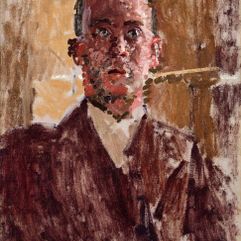

Harold Gilman
1876 - 1919
Harold John Wilde Gilman was a British painter of interiors, portraits and landscapes, and a founder-member of the Camden Town Group.
Painting career
Meeting Walter Sickert in 1907, Gilman became a founder member of both the Fitzroy Street Group (in 1907) and the Camden Town Group (in 1911). In the meantime he joined the Allied Artists' Association, moved to Letchworth, and began to show influence from work of Vuillard as well as Sickert.
In 1910 he was stimulated by the first post-Impressionist exhibition at the Grafton Galleries, and visited Paris with Ginner. He soon outpaced Sickert's understanding of post-Impressionism and moved out from under his shadow, using ever stronger colour, under the influence of Van Gogh, Gauguin and Signac. In 1913 he exhibited jointly with Gore, and became the first president of the London Group, and identified with Charles Ginner as a 'Neo-Realist', exhibiting with Ginner under that label in 1914.
Gilman visited Scandinavia in 1912 and 1913, and may have travelled with the artist William Ratcliffe, who had relations there. Gilman made studies of the environment, and painted Canal Bridge, Flekkefjord, an accurate depiction, whose subject is likely to have been inspired by Van Gogh's depiction of a similar bridge in Provence. Gilman had rejected Van Gogh's work when he first encountered it, but later became a strong admirer. According to Wyndham Lewis, he kept postcards of Van Gogh's work on his wall and sometimes hung one of his own works next to them, if he was especially satisfied with it.
In 1914 he joined Robert Bevan's short-lived Cumberland Market Group, with Charles Ginner and (later) John Nash. In 1915 the group held their only exhibition.
He taught at the Westminster School of Art where he influenced students who included Mary Godwin, Ruth Doggett, and Marjorie Sherlock. He then started his own school with Ginner.
In 1918 he was commissioned to travel to Nova Scotia by the Canadian War Records; and painted a picture of Halifax Harbour for the War Memorial at Ottawa.
He died in London on 12 February 1919, of the Spanish flu.
Text courtesy of Wikipedia, 2024










